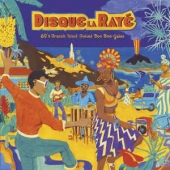
Various Artists
Disque La Raye - 60's French West-indies Boo-boo-galoo
Label: Born Bad
Genre: Freestyle / Nu Jazz / Funk / Afro
Availability
- LP €17.49 Out of Stock
At each performance, it's the same folly, and the New York dancefloors are shaking. The sextet of Joe Cuba reaches an incredible level of notoriety thanks to this new piece, a bomb aptly titled "Bang Bang". Many other detonations of the same kind resonate soon in the ballrooms of the Big Apple. During the year 1966, a new rhythm spreads like a train of powder on the sidewalks of Spanish Harlem and the waves of the local radios. "Boogaloo", they say. Like no other genre before, this music brings together African-Americans and Hispanics. These neighboring communities frequented the same parties for a long time, but did not walk on the same tracks: the blacks waited for series of blues and soul rhythms while the latinos reserved for cha-cha-cha and pachanga. The ultimate syncretism of the styles in vogue in the Barrio, boogaloo is often referred to as "the first Nuyorican music. "
If the purists say that we can detect the beginnings on the resumption of "Watermelon Man" by Mongo Santamaria, or "El Watusi" by Ray Barretto in 1963, it is truly from 1966 that it is necessary as the most brilliant incarnation of his time, both musically and politically. As a hurricane of revolution then blows on the ameriKKK: in the wake of the claims of the Black Panthers and the Young Lords Organization, minorities gather in the street to extort their rights to the establishment. The naivety of the lyrics of "I Like It Like That", recorded by Pete Rodriguez's orchestra for Alegre Records in 1966, is misleading: it must above all be interpreted as the most direct expression, the most dazzling affirmation of an identity. Blacks and Hispanics assume their skin color and their origins while claiming to be American. The boogaloo is engrossed on the soundtrack of a social revolution that ignites the country, it will give the tempo until the twilight of the 60s (before being in turn eclipsed by the salsa.)
"The Boogaloo, it's the young people who try to get out of it, it is the contribution of the immigrants, and the musical evolution! " Bawls Johnny Colon in the excellent documentary We Like It Like That , must see.
The energy of boogaloo also seduces the youth of other horizons, beyond the borders of the United States, and particularly in the Caribbean cradle: in Cuba, Puerto Rico, in Dominica, and also in the French Antilles. From Fort-de-France to Pointe-à-Pitre, modern rhythms turn the old biguines and mazurka of the great West Indian orchestras, whose nobility was transmitted through long lineages of virtuosos, from father to son among the Siobud, Stellio, Fanfant, or Coppet. When the boogaloo lands in the "sugar islands" along with other musical genres with amplified keyboards and electrified guitars, this new wave disrupts hierarchies and uses: it's useless to know how to read music to claim to be a musician now,"I was in Paris for my studies in the early sixties," says Fred Aucagos, the first rocker in Guadeloupe. But I was not going too far, I attended the Golf Drouot, with Eddy, Johnny, Dick Rivers ... When I returned to Guadeloupe in January 1966, I brought back to the island the first reverb amp and the first electric guitar. I was there, I wanted to play this music at home. "Aucagos begins by revisiting the standards of French and Yankee rock, but the musicians of his group, the Vikings of Guadeloupe, quickly persuade him to sing in Creole, then to integrate drums ka, to enlist Latin brass ... We hear on "Ti Man'zelle" by Fred Aucagos, a mix of imports from the metropolis, the United States and neighboring islands. With, ultimately, an ultimate desire: to burn the West Indian balls.
On the track of prestigious clubs, La Bananeraie in Martinique and the Cocoteraie in Guadeloupe for example, the musicians try boogaloo in interpretations rarely very orthodox, and that is what gives this compilation its singularity and its plume. It incorporates influences from the African continent thanks to Rico Jazz (an adaptation of "Si Tu Bois Beaucoup" by Congolese OK Jazz rumba orchestra). We rub the "Jerk Vide" of a David Martial who has not yet disguised in cliche dudouist. With the banter of Guyanese Dany Play ("But You Know"), and the petulance of Joby Valente ("Disk The Striped" with Camille Soprann 'on saxophone), one (re) discovers standards published half a century ago on the two historic labels in Guadeloupe: Aux Ondes of the producer Raymond Célini,
In another genre, Monsieur X's "Ou Que Di Moin" is a Creole funk pamphlet, neither Latin nor festive, not strictly boogaloo. For the Nuyorican rhythm was only a tiny part of what the Caribbean orchestras played, and he easily integrated elements of biguine or Haitian compa. This compilation allows for small differences, for fun, assuming pieces on which the boogaloo is primarily an influence. With the help of Jean-Baptiste Guillot from the label Born Bad, the digger Julien Achard looked for some of these records not less than three years, to gather here the best of boogaloo creole. The charm of the restored sound of these old irresistible singles is matched only by the ardor of the interpretations. "Wildly Sexy", as sung by Gaby Siarras.
David Commeillas
